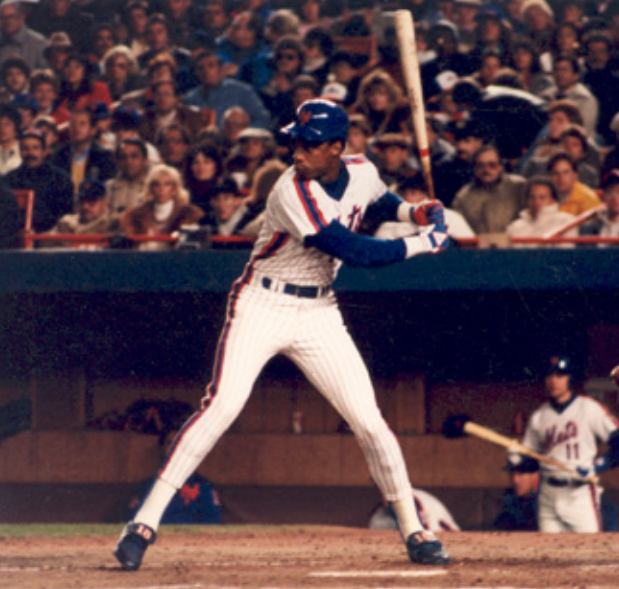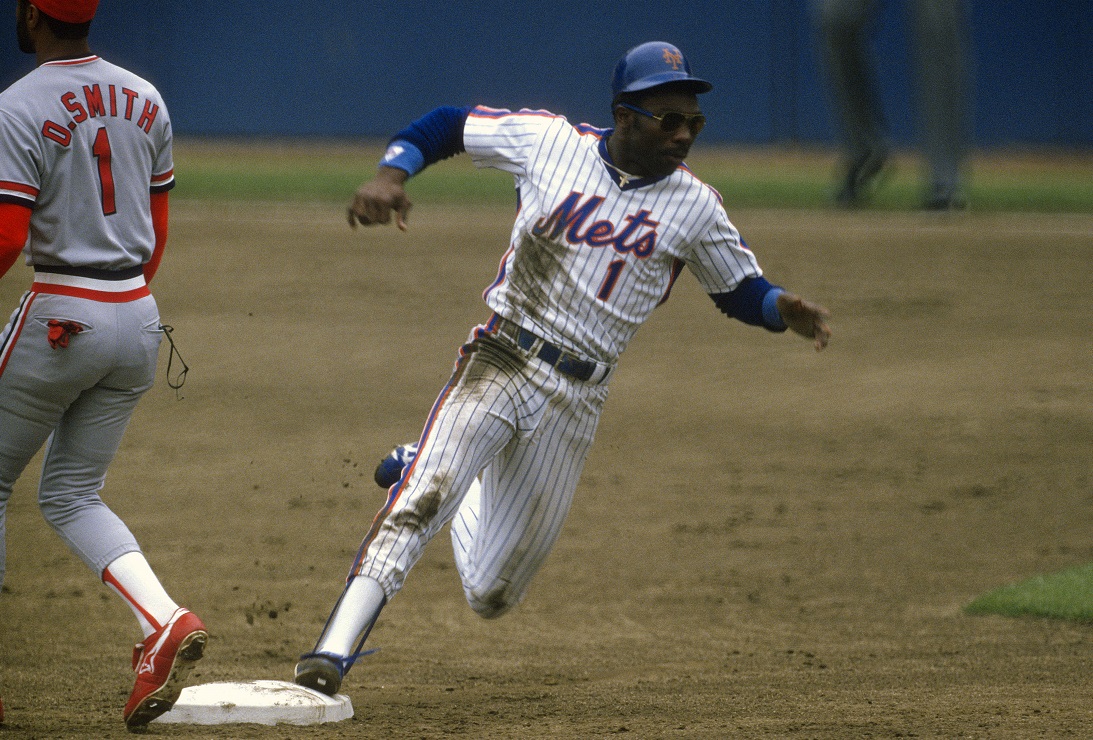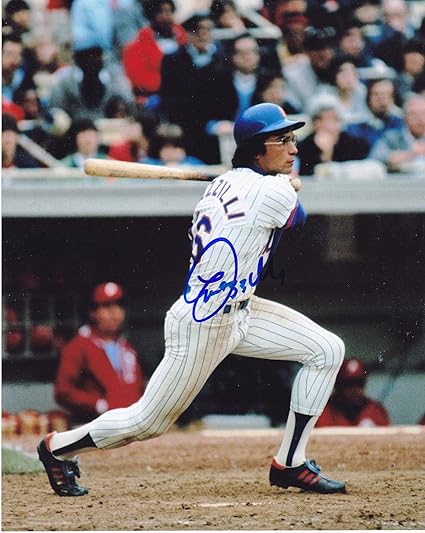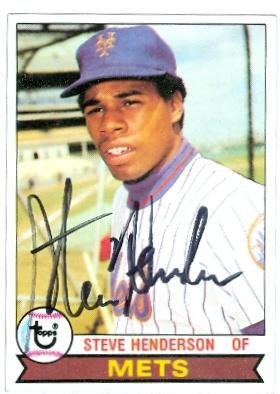Most teams shuffle players from position to position in the outfield, though some tend to be solitary figures in centerfield or in right. For purposes of our Mets history, let’s consider all outfielders as a group and see who is the most memorable to the club in a good way over their nearly 60-year history of being in the National League.
The sweet swinging Cleon Jones actually leads all Mets outfielders in games played for the team. If not for his infamous off-field incident during Spring Training in Florida and the misunderstood removal by Gil Hodges when he was ailing, it was mostly a good road for Jones throughout his Mets career. The best effort was during the World Series year of 1969 when he finished the season hitting .340. There was a big dropoff to .277 in 1970 but he bounced right back in 1971 to hit .319. For his 12 year Mets career he hit .281 overall.
Darryl Strawberry had Hall of Fame potential based upon his great power, baserunning speed and his arm, but his personal demons got in the way of his career numbers. While his NY Mets batting average of .261 was not eye popping, he three times threatened to cross the 40-mark with home runs and three times eclipsed 100 RBIs. He also had seasons with as many as 36 stolen bases, winning Rookie of the Year and following that up with eight straight All Star Game appearances. In those eight Mets seasons he hit 252 HRs and drove in 733 with 191 stolen bases.
One of the most popular players ever to don a Mets uniform was speedster Mookie Wilson. His legs were so good that every single or walk threatened to turn into extra bases via the stolen base. He swiped as many as 58 bases in a single season, batting .276 over his ten years playing for the Mets. He didn’t have much power, but he still was a steady contributor whose big smile made him a favorite of the fans.
Perhaps the biggest free agent the Mets had ever acquired, Carlos Beltran got off to a bit of a slow start to his Mets career making him look like a bad investment. However, he quickly put that season behind him and during his second campaign went from 16 HRs to 41. He was a five-time All Star, three-time Gold Glove winner and hit .280 over the course of his 6+ years in New York. He also made himself into a weapon as a base stealer. Of course, his recent implication in the Astros cheating scandal will forever tarnish the otherwise solid memories of what he did for New York and what he might have done as Mets manager.
One of the least well regarded Mets outfielders was Kevin McReynolds. Granted, he played with the enthusiasm of an undertaker, but you can’t argue with the numbers. During his first five year stint with the club he eclipsed 80 RBIs twice and 95 RBIs twice. That’s pretty impressive offense. In fact, in 1988 with 27 HRs, 99 RBIs and a .288 AVG he finished 3rd in the MVP race. Still, the fans never really took to McReynolds. He arrived as part of an eight player deal with three pieces coming to the Mets and five going to the Padres. The problem is one of those five pieces was named Kevin Mitchell, who, despite his own idiosyncrasies, turned into one of the best hitters in the league. He had a second stint with the Mets for his final season, arriving one-on-one for problem child Vince Coleman. He didn’t do much for the Mets and Coleman went on to steal bases prolifically for the next three years.
Homegrown hero Lee Mazzilli was a fan favorite with movie star looks and often highly credible offense. He played around the outfield (with the occasional assignment to 1st base as well). In his first Mets stint he did well, earning an All Star berth once in 1979, stealing as many as 41 bases in a season and usually hitting between 10 and 16 HRs. He came back to the Mets late in his career and still showed some offensive potential. Overall for the Mets he hit .264 over parts of ten seasons.
It was almost unbelievable that the Mets were able to convince the White Sox to part with young centerfielder Tommie Agee. After all, he’d won Rookie of the Year in 1966 when he hit 22 HRs, drove in 86, stole 44 bases and batted .273 while earning his first Gold Glove. There was a big dropoff in the second year with significant dips in all offensive categories and the Comisky folks felt a deal that included one-year Met Tommy Davis was worth making after he finished with .302, 16 HRs and 73 RBIs. Davis never again achieved any baseball honors but did play for quite a long time after the deal. Agee was a fixture for the Mets for five seasons during which he found his name in the MVP voting twice and earned his second Gold Glove. Injuries took their toll on Agee and he was out of baseball at age 30.
Between his World Series defensive heroics and his latter day career as a New York City sports broadcaster, young slugger Ron Swoboda also earned the fans’ affection. As a mere babe of 21 he hit 19 HRs for the Mets and stayed in the 50+ RBI range for his six years in New York. His .242 average was not much and he fanned a bit too much, but he had the swagger that made him seem like a bigger player than he turned out to be.
As much as the fans had disdain for the watered down version of George Foster in a Mets uniform, the fact remains he was in their top ten of games played in the Shea Stadium outfield. He never posted the MVP numbers like he did in Cincinnati, but considering he was already 33 when donning the orange and blue, his numbers were not awful. In his second season he hit 28 HRs and he drove in 90. He followed that up with a season of 24 and 86 respectively. Probably the part that hurt the most was not the reduced run production, but the .252 average he put up during his five years with the Mets. Considering they only gave up Alex Trevino, Greg Harris and Jim Kern to get him, you really can’t complain about what you got.
Having made a few stints with the Mets, Rusty Staub turned into one of the team’s most popular outfielders. Who can forget his sidearm throws due to injury? However, it was his bat that earned him the grace of New York ticket holders. His second stint was more of a pinch hitter extraordinaire, but overall he provided very good offense over parts of nine seasons. He hit .276 as a Met and his best ever performance was in the lost season of 1975 when he hit .280 with 19 HRs and 105 RBIs. The day he passed away you could feel the huge loss of Le Grande Orange.
Like Carlos Beltran before him, Curtis Granderson’s rookie season was pretty much forgettable. A free agent acquisition, the Mets were hoping to see the 41 HR and 119 RBI player the Yankees had in 2011. Instead they got 20 HRs, 66 RBIs and an average below .230. He did step it up a bit after that, and for his Mets career he hit as many as 30 HRs but never surpassed 70 in RBIs. Still, his professionalism and articulation made him popular with the fans (if not with the front office for what they were paying him).
One of the four players coming to the Mets in the legendarily bad Tom Seaver trade, Steve Henderson did manage to earn himself 2nd place in the Rookie of the Year voting based upon his 99 game debut in 1977. Henderson kept up his solid hitting for his four years in New York, finishing that period with a .287 average and using his legs and his run production bat to earn fans despite the sour memory of why he was in Queens.
For a guy who has had more fame after his big league career than during it, Lenny Dykstra provided the Mets with great baserunning speed and modest power. He finished his five years in New York with a .278 average, stealing as many as 30 bases twice. He was dealt to the Phillies during the 1989 season for a spectacularly bad deal in which he and Roger McDowell (plus a player to be named later) netted the soon-to-be-outfielder Juan Samuel who was allowed to leave after hitting .228 in his single season in NY. Dykstra went on to have PED-fueled success for the City of Brotherly Love for 8 more years, earning All Star status three times.
If and when baseball ever resumes you will have to add outfielder Michael Conforto to the list of long term productive Mets players. He arrived to help them get to the post-season in 2015 and despite missing time with injuries, has put together a formidable offensive resume. Last season he reached career highs with 33 HRs and 92 RBIs.
Surely there were many more players who stood out for shorter periods with the Mets, but this group had longer terms and mostly success.








.jpg)




6 comments:
Seems like a fine list of outfielders until you realize there are 3 outfield spots spanning nearly 60 years. That said, the collective strong OF talent over the years has been sparse, with too many Matt den Deckers and Dave Schnecks to count.
One reason I am sad about 2020. This team would have a fine offensive outfield - if they do in fact play.
Great list Reese. My the '86 Outfield was my favorite: Mookie, Straw, Dykstra, and Kevin Mitchell.
A very impressive list.
Lets see... 57 seasons... 3 starters... that's 171 starting outfielders.
You are right Tom. List should be much longer.
Would be different article, but my "in-their-prime" onetime Met OF is Mays, Snider & Bonilla with George Foster & Richie Asburn on the bench.
The rest of that team is pretty good too.
Hobie, no Rickey Henderson?
No Roger Cedeno?
Post a Comment